Controls of Land Surface Temperature between and within Local Climate Zones: A Case Study of Harare in Zimbabwe
Abstract
:1. Introduction
2. Datasets and Methods
2.1. The City of Harare
2.2. Mapping of Local Climate Zones
2.3. Retrieval of Land Surface Temperature Using a Single Channel Algorithm
2.4. Processing of Elevation Data and Retrieval Landsat 8-Derived Indices
2.5. Analysis of LST Variations between and within LCZ
2.5.1. LST Variations between LCZs
2.5.2. LST Variations within LCZs
2.6. Summary of Approach Used in This Study
3. Results and Discussions
3.1. Distribution of Drivers of Land Surface Temperature Variations in Harare
3.2. Accuracy of LCZ Mapping
3.3. Transformed Divergence Separability Index (TDSI)
3.4. LCZ Map and Variations of LST in Harare
3.5. Correlation of LST and Indices of Land Surface Characteristics in Harare
3.6. Relative Contribution of LCZs to Warming and Cooling in Harare
3.7. Intra-LCZ Correlation of LST and Indices of Land Surface Characteristics
3.8. Comparison of LST Drivers at City and Intra-LCZ Scales
Discussion of Findings
4. Shortcomings of the Study
5. Conclusions and Recommendations
Author Contributions
Funding
Informed Consent Statement
Data Availability Statement
Acknowledgments
Conflicts of Interest
References
- Zhang, H.; Qi, Z.F.; Ye, X.Y.; Cai, Y.B.; Ma, W.C.; Chen, M.N. Analysis of land use/land cover change, population shift, and their effects on spatiotemporal patterns of urban heat islands in metropolitan Shanghai, China. Appl. Geogr. 2013, 44, 121–133. [Google Scholar] [CrossRef]
- Zhou, X.; Wang, Y.C. Spatial-temporal dynamics of urban green space in response to rapid urbanization and greening policies. Landsc. Urban Plan. 2011, 100, 268–277. [Google Scholar] [CrossRef]
- Acharya, T.D.; Parajuli, J.; Shahi, K.; Poudel, D.; Yang, I. Extraction and Modelling of Spatio-Temporal Urban Change in Kathmandu Valley. Int. J. IT Eng. Appl. Sci. Res. 2015, 4, 1–11. [Google Scholar]
- Jalan, S.; Sharma, K. Spatio-temporal assessment of land use/ land cover dynamics and urban heat island of Jaipur city using satellite data. Int. Arch. Photogramm. Remote Sens. Spat. Inf. Sci. ISPRS Arch. 2014, XL-8, 767–772. [Google Scholar] [CrossRef] [Green Version]
- Valdiviezo-N, J.C.; Téllez-Quiñones, A.; Salazar-Garibay, A.; López-Caloca, A.A. Built-up index methods and their applications for urban extraction from Sentinel 2A satellite data: Discussion. J. Opt. Soc. Am. A 2018, 35, 35. [Google Scholar] [CrossRef] [PubMed]
- Polydoros, A.; Cartalis, C. Assessing thermal risk in urban areas—An application for the urban agglomeration of Athens. Adv. Build. Energy Res. 2014, 8, 74–83. [Google Scholar] [CrossRef]
- McMichael, A.J.; Woodruff, R.E.; Hales, S. Climate change and human health: Present and future risks. Lancet 2006, 367, 859–869. [Google Scholar] [CrossRef]
- Harlan, S.L.; Ruddell, D.M. Climate change and health in cities: Impacts of heat and air pollution and potential co-benefits from mitigation and adaptation. Curr. Opin. Environ. Sustain. 2011, 3, 126–134. [Google Scholar] [CrossRef]
- Pérez-Andreu, V.; Aparicio-Fernández, C.; Martínez-Ibernón, A.; Vivancos, J.L. Impact of climate change on heating and cooling energy demand in a residential building in a Mediterranean climate. Energy 2018, 165, 63–74. [Google Scholar] [CrossRef]
- Guhathakurta, S.; Gober, P. The impact of the Phoenix urban heat Island on residential water use. J. Am. Plan. Assoc. 2007, 73, 317–329. [Google Scholar] [CrossRef]
- Fu, Y.; Lu, X.; Zhao, Y.; Zeng, X.; Xia, L. Assessment impacts of weather and land use/land cover (LULC) change on urban vegetation net primary productivity (NPP): A case study in guangzhou, China. Remote Sens. 2013, 5, 4125–4144. [Google Scholar] [CrossRef]
- Mbithi, D.M.; Demessie, E.T.; Kashiri, T. The Impact of Land Use Land Cover (LULC) Changes on Land Surface Temperature (LST); A Case Study of Addis Ababa City, Ethiopia; Kenya Meteorological Services: Nairobi, Kenya, 2006. [Google Scholar]
- Ullah, S.; Ahmad, K.; Sajjad, R.U.; Abbasi, A.M.; Nazeer, A.; Tahir, A.A. Analysis and simulation of land cover changes and their impacts on land surface temperature in a lower Himalayan region. J. Environ. Manag. 2019, 245, 348–357. [Google Scholar] [CrossRef] [PubMed]
- Shugar, D.H.; Jacquemart, M.; Shean, D.; Bhushan, S.; Upadhyay, K.; Sattar, A.; Schwanghart, W.; McBride, S.; De Vries, M.V.W.; Mergili, M. A massive rock and ice avalanche caused the 2021 disaster at Chamoli, Indian Himalaya. Science 2021, 373, 300–306. [Google Scholar] [CrossRef]
- Bechtel, B.; Langkamp, T.; Böhner, J.; Daneke, C.; Oßenbrügge, J.; Schempp, S. Classification and Modelling of Urban Micro-Climates Using Multisensoral and Multitemporal Remote Sensing Data. ISPRS—Int. Arch. Photogramm. Remote Sens. Spat. Inf. Sci. 2012, XXXIX-B8, 463–468. [Google Scholar] [CrossRef] [Green Version]
- Demuzere, M.; Bechtel, B.; Mills, G. Urban Climate Global transferability of local climate zone models. Urban Clim. 2019, 27, 46–63. [Google Scholar] [CrossRef]
- Bechtel, B.; Demuzere, M.; Mills, G.; Zhan, W.; Sismanidis, P.; Small, C.; Voogt, J. Urban Climate SUHI analysis using Local Climate Zones—A comparison of 50 cities. Urban Clim. 2019, 28, 100451. [Google Scholar] [CrossRef]
- Dimitrov, S.; Popov, A.; Iliev, M. An Application of the LCZ Approach in Surface Urban Heat Island Mapping in Sofia, Bulgaria. Atmosphere 2021, 12, 1370. [Google Scholar] [CrossRef]
- Cai, M.; Ren, C.; Xu, Y.; Dai, W.; Wang, X.M. Local Climate Zone Study for Sustainable Megacities Development by Using Improved WUDAPT Methodology—A Case Study in Guangzhou. Procedia Environ. Sci. 2016, 36, 82–89. [Google Scholar] [CrossRef] [Green Version]
- Cai, M.; Ren, C.; Xu, Y.; Lau, K.K.; Wang, R. Urban Climate Investigating the relationship between local climate zone and land surface temperature using an improved WUDAPT methodology—A case study of Yangtze River Delta, China. Urban Clim. 2017, 24, 485–502. [Google Scholar] [CrossRef]
- Danylo, O.; See, L.; Bechtel, B.; Schepaschenko, D.; Fritz, S. Contributing to WUDAPT: A Local Climate Zone Classification of Two Cities in Ukraine. IEEE J. Sel. Top. Appl. Earth Obs. Remote Sens. 2016, 9, 1841–1853. [Google Scholar] [CrossRef] [Green Version]
- Cai, M.; Ren, C.; Xu, Y. Investigating the relationship between Local Climate Zone and land surface temperature. In Proceedings of the 2017 Joint Urban Remote Sensing Event (JURSE), Dubai, United Arab Emirates, 6–8 March 2017; pp. 1–4. [Google Scholar] [CrossRef]
- Zhou, X.; Okaze, T.; Ren, C.; Cai, M.; Ishida, Y.; Watanabe, H.; Mochida, A. Evaluation of urban heat islands using local climate zones under the influences of sea-land breeze. Sustain. Cities Soc. 2020, 55, 102060. [Google Scholar] [CrossRef]
- Al Kafy, A.; Dey, N.N.; Al Rakib, A.; Rahaman, Z.A.; Nasher, N.M.R.; Bhatt, A. Modeling the relationship between land use/land cover and land surface temperature in Dhaka, Bangladesh using CA-ANN algorithm. Environ. Chall. 2021, 4, 100190. [Google Scholar] [CrossRef]
- Tursilowati, L. Urban Climate Analysis on The Land Use and Land Cover Change (LULC) in Bandung-Indonesia with Remote Sensing and GIS. In Proceedings of the United Nation/Austria/ESA Symposium on Space Tools and Solutions for Monitoring the Atmosphere in Support of Sustainable Development, Graz, Austria, 11–14 September 2007; pp. 11–14. [Google Scholar]
- Tyubee, B.T.; Anyadike, R.N.C. Investigating the Effect of Land Use / Land Cover on Urban Surface Temperature in Makurdi, Nigeria. In Proceedings of the ICUC9—9th International Conference on Urban Climate Jointly with 12th Symposium on the Urban Environment, Toulouse, France, 20–24 July 2015. [Google Scholar]
- Tran, D.X.; Pla, F.; Latorre-Carmona, P.; Myint, S.W.; Caetano, M.; Kieu, H.V. Characterizing the relationship between land use land cover change and land surface temperature. ISPRS J. Photogramm. Remote Sens. 2017, 124, 119–132. [Google Scholar] [CrossRef] [Green Version]
- Fricke, C.; Pongrácz, R.; Gál, T.; Savić, S.; Unger, J. Using local climate zones to compare remotely sensed surface temperatures in temperate cities and hot desert cities. Morav. Geogr. Rep. 2020, 28, 48–60. [Google Scholar] [CrossRef]
- Mushore, T.D.; Dube, T.; Manjowe, M.; Gumindoga, W.; Chemura, A.; Rousta, I.; Odindi, J.; Mutanga, O. Remotely sensed retrieval of Local Climate Zones and their linkages to land surface temperature in Harare metropolitan city, Zimbabwe. Urban Clim. 2019, 27, 259–271. [Google Scholar] [CrossRef]
- Stewart, I.D.; Oke, T.R.; Krayenhoff, E.S. Evaluation of the “local climate zone” scheme using temperature observations and model simulations. Int. J. Climatol. 2014, 34, 1062–1080. [Google Scholar] [CrossRef]
- Badaro-saliba, N.; Adjizian-gerard, J.; Zaarour, R.; Najjar, G. LCZ scheme for assessing Urban Heat Island intensity in a complex urban area (Beirut, Lebanon). Urban Clim. 2021, 37, 100846. [Google Scholar] [CrossRef]
- Zhao, C.; Jensen, J.L.R.; Weng, Q.; Currit, N. Use of Local Climate Zones to investigate surface urban heat islands in Texas Use of Local Climate Zones to investigate surface urban heat islands in Texas ABSTRACT. GIScience Remote Sens. 2020, 57, 1083–1101. [Google Scholar] [CrossRef]
- Zhang, X.; Estoque, R.C. Capturing urban heat island formation in a subtropical city of China based on Landsat images: Implications for sustainable urban development. Environ. Monit. Assess. 2021, 193, 130. [Google Scholar] [CrossRef]
- Nassar, A.K.; Blackburn, G.A.; Whyatt, J.D. International Journal of Applied Earth Observation and Geoinformation Dynamics and controls of urban heat sink and island phenomena in a desert city: Development of a local climate zone scheme using remotely-sensed inputs. Int. J. Appl. Earth Obs. Geoinf. 2016, 51, 76–90. [Google Scholar] [CrossRef]
- Budhiraja, B.; Gawuc, L.; Agrawal, G. Seasonality of Surface Urban Heat Island in Delhi City Region Measured by Local Climate Zones and Conventional Indicators. IEEE J. Sel. Top. Appl. Earth Obs. Remote Sens. 2019, 12, 5223–5232. [Google Scholar] [CrossRef]
- Dian, C.; Pongrácz, R.; Dezső, Z.; Bartholy, J. Annual and monthly analysis of surface urban heat island intensity with respect to the local climate zones in Budapest. Urban Clim. 2020, 31, 100573. [Google Scholar] [CrossRef]
- Farina, A. Exploring the Relationship between Land Surface Temperature and Vegetation Abundance for Urban Heat Island Mitigation in Seville, Spain. LUMA-. GIS Thesis, Lund University, Lund, Sweden, 2012; p. 50. [Google Scholar]
- Buyadi, S.N.A.; Mohd, W.M.N.W.; Misni, A. Impact of vegetation growth on urban surface temperature distribution. IOP Conf. Ser. Earth Environ. Sci. 2014, 18, 1627–1634. [Google Scholar] [CrossRef] [Green Version]
- Zhang, X.; Zhong, T.; Feng, X.; Wang, K. Estimation of the relationship between vegetation patches and urban land surface temperature with remote sensing. Int. J. Remote Sens. 2009, 30, 2105–2118. [Google Scholar] [CrossRef]
- Rasul, A.; Balzter, H.; Smith, C. Spatial variation of the daytime Surface Urban Cool Island during the dry season in Erbil, Iraqi Kurdistan, from Landsat 8. Urban Clim. 2015, 14, 176–186. [Google Scholar] [CrossRef] [Green Version]
- McFeeters, S.K. The use of the Normalized Difference Water Index (NDWI) in the delineation of open water features. Int. J. Remote Sens. 1996, 17, 1425–1432. [Google Scholar] [CrossRef]
- Karnieli, A.; Agam, N.; Pinker, R.T.; Anderson, M.; Imhoff, M.L.; Gutman, G.G.; Panov, N.; Goldberg, A. Use of NDVI and land surface temperature for drought assessment: Merits and limitations. J. Clim. 2010, 23, 618–633. [Google Scholar] [CrossRef]
- Gandhi, G.M.; Parthiban, S.; Thummalu, N.; Christy, A. Ndvi: Vegetation change detection using remote sensing and gis—A case study of Vellore District. Procedia Procedia Comput. Sci. 2015, 57, 1199–1210. [Google Scholar] [CrossRef] [Green Version]
- Kostadinov, T.S.; Schumer, R.; Hausner, M.; Bormann, K.J.; Gaffney, R.; McGwire, K.; Painter, T.H.; Tyler, S.; Harpold, A.A. Watershed-scale mapping of fractional snow cover under conifer forest canopy using lidar. Remote Sens. Environ. 2019, 222, 34–49. [Google Scholar] [CrossRef]
- Muhuri, A.; Gascoin, S.; Menzel, L.; Kostadinov, T.S.; Harpold, A.A.; Sanmiguel-Vallelado, A.; López-Moreno, J.I. Performance Assessment of Optical Satellite-Based Operational Snow Cover Monitoring Algorithms in Forested Landscapes. IEEE J. Sel. Top. Appl. Earth Obs. Remote Sens. 2021, 14, 7159–7178. [Google Scholar] [CrossRef]
- Zha, Y.; Gao, J.; Ni, S. Use of normalized difference built-up index in automatically mapping urban areas from TM imagery. Int. J. Remote Sens. 2003, 24, 583–594. [Google Scholar] [CrossRef]
- Xu, H. Modification of normalised difference water index (NDWI) to enhance open water features in remotely sensed imagery. Int. J. Remote Sens. 2006, 27, 3025–3033. [Google Scholar] [CrossRef]
- Sun, Q.; Wu, Z.; Tan, J. The relationship between land surface temperature and land use/land cover in Guangzhou, China. Environ. Earth Sci. 2012, 65, 1687–1694. [Google Scholar] [CrossRef]
- Huang, Q.; Xu, H.; Yang, X.; Shi, P. Study of impacts of urbanization process on phenology using multisource satellite data. In Proceedings of the American Society for Photogrammetry and Remote Sensing Annual Conference 2009 (ASPRS 2009), Baltimore, Maryland, 9–13 March 2009; Volume 1, pp. 300–305. [Google Scholar]
- Mushore, T.D.; Odindi, J.; Dube, T.; Mutanga, O. Prediction of future urban surface temperatures using medium resolution satellite data in Harare metropolitan city, Zimbabwe. Build. Environ. 2017, 122, 397–410. [Google Scholar] [CrossRef]
- Kayet, N.; Pathak, K.; Chakrabarty, A.; Sahoo, S. Urban heat island explored by co-relationship between land surface temperature vs multiple vegetation indices. Spat. Inf. Res. 2016, 24, 515–529. [Google Scholar] [CrossRef]
- Lee, L.; Chen, L.; Wang, X.; Zhao, J. Use of Landsat TM/ETM+ data to analyze urban heat island and its relationship with land use/cover change. In Proceedings of the 2011 International Conference on Remote Sensing, Environment and Transportation Engineering, Nanjing, China, 24–26 June 2011; pp. 922–927. [Google Scholar] [CrossRef]
- Li, H.; Liu, Q. Comparison of NDBI and NDVI as indicators of surface urban heat island effect in MODIS imagery. Int. Conf. Earth Obs. Data Process. Anal. 2008, 7285, 728503. [Google Scholar] [CrossRef]
- Chen, X.L.; Zhao, H.M.; Li, P.X.; Yin, Z.Y. Remote sensing image-based analysis of the relationship between urban heat island and land use/cover changes. Remote Sens. Environ. 2006, 104, 133–146. [Google Scholar] [CrossRef]
- ZIMSTAT Provincial Report: Harare Stat. (ed.). Harare Zimbabwe Gov. Zimbabwe 2012. Available online: https://www.zimstat.co.zw/wp-content/uploads/publications/Population/population/Harare.pdf (accessed on 10 October 2022).
- ZIMSTAT Population and Housing Census 2022: Preliminary Report of Population Figures. Zimbabwe Gov. Zimbabwe 2022. Available online: https://zimbabwe.unfpa.org/sites/default/files/pub-pdf/2022_population_and_housing_census_preliminary_report_on_population_figures.pdf (accessed on 10 October 2022).
- Kamusoko, C.; Gamba, J.; Murakami, H. Monitoring urban spatial growth in Harare Metropolitan province, Zimbabwe. Adv. Remote Sens. 2013, 2, 322–331. [Google Scholar] [CrossRef] [Green Version]
- Wania, A.; Kemper, T.; Tiede, D.; Zeil, P. Mapping recent built-up area changes in the city of Harare with high resolution satellite imagery. Appl. Geogr. 2014, 46, 35–44. [Google Scholar] [CrossRef]
- Shi, Y.; Lau, K.K.; Ren, C.; Ng, E. Urban Climate Evaluating the local climate zone classi fi cation in high-density heterogeneous urban environment using mobile measurement. Urban Clim. 2018, 25, 167–186. [Google Scholar] [CrossRef]
- Kotharkar, R.; Bagade, A. Urban Climate Local Climate Zone classi fi cation for Indian cities: A case study of Nagpur. Urban Clim. 2017, 24, 369–392. [Google Scholar] [CrossRef]
- Bhatti, S.S.; Tripathi, N.K. Built-up area extraction using Landsat 8 OLI imagery. GIScience Remote Sens. 2014, 51, 445–467. [Google Scholar] [CrossRef] [Green Version]
- Ejiagha, I.R.; Ahmed, M.R.; Hassan, Q.K.; Dewan, A.; Gupta, A.; Rangelova, E. Use of Remote Sensing in Comprehending the Influence of Urban Landscape’s Composition and Configuration on Land Surface Temperature at Neighbourhood Scale. Remote Sens. 2020, 12, 2508. [Google Scholar] [CrossRef]
- Ahmed, B.; Kamruzzaman, M.D.; Zhu, X.; Shahinoor Rahman, M.D.; Choi, K. Simulating land cover changes and their impacts on land surface temperature in dhaka, bangladesh. Remote Sens. 2013, 5, 5969–5998. [Google Scholar] [CrossRef] [Green Version]
- Xu, H. A new index for delineating built-up land features in satellite imagery. Int. J. Remote Sens. 2008, 29, 4269–4276. [Google Scholar] [CrossRef]
- Odindi, J.O.; Bangamwabo, V.; Mutanga, O. Assessing the value of urban green spaces in mitigating multi-seasonal urban heat using MODIS land surface temperature (LST) and landsat 8 data. Int. J. Environ. Res. 2015, 9, 9–18. [Google Scholar] [CrossRef]
- U.S. Geological Survey Landsat 8 Data Users Handbook; Nasa: Washington, DC, USA, 2019; Volume 8, p. 97. Available online: https://landsat.usgs.gov/documents/Landsat8DataUsersHandbook.pdf (accessed on 1 September 2022).
- Roy, D.P.; Wulder, M.A.; Loveland, T.R.; Woodcock, C.E.; Allen, R.G.; Anderson, M.C.; Helder, D.; Irons, J.R.; Johnson, D.M.; Kennedy, R. Landsat-8: Science and product vision for terrestrial global change research. Remote Sens. Environ. 2014, 145, 154–172. [Google Scholar] [CrossRef] [Green Version]
- Acharya, T.D.; Yang, I. Exploring landsat 8. Int. J. IT Eng. Appl. Sci. Res. 2015, 4, 4–10. [Google Scholar]
- Matongera, T.N.; Mutanga, O.; Dube, T.; Sibanda, M. Detection and mapping the spatial distribution of bracken fern weeds using the Landsat 8 OLI new generation sensor. Int. J. Appl. Earth Obs. Geoinf. 2017, 57, 93–103. [Google Scholar] [CrossRef]
- Sheykhmousa, M.; Mahdianpari, M.; Ghanbari, H. Support Vector Machine vs. Random Forest for Remote Sensing Image Classification: A Meta-analysis and systematic review. IEEE J. Sel. Top. Appl. Earth Obs. Remote Sens. 2020, 13, 6308–6325. [Google Scholar] [CrossRef]
- Gislason, P.O.; Benediktsson, J.A.; Sveinsson, J.R. Random Forest Classification of Multisource Remote Sensing and Geographic Data. IEEE Geosci. Remote Sens. Lett. 2004, 2, 1049–1052. [Google Scholar]
- Pal, M. Random forest classifier for remote sensing classification. Int. J. Remote Sens. 2005, 26, 217–222. [Google Scholar] [CrossRef]
- Hansen, M.C.; Potapov, P.V.; Moore, R.; Hancher, M.; Turubanova, S.A.; Tyukavina, A.; Thau, D.; Stehman, S.V.; Goetz, S.J.; Loveland, T.R. High-resolution global maps of 21st-century forest cover change. Science 2013, 342, 850–853. [Google Scholar] [CrossRef] [PubMed] [Green Version]
- Maimaitiyiming, M.; Ghulam, A.; Tiyip, T.; Pla, F.; Latorre-Carmona, P.; Halik, Ü.; Sawut, M.; Caetano, M. Effects of green space spatial pattern on land surface temperature: Implications for sustainable urban planning and climate change adaptation. ISPRS J. Photogramm. Remote Sens. 2014, 89, 59–66. [Google Scholar] [CrossRef] [Green Version]
- Van De Griend, A.A.; Owe, M. On the relationship between thermal emissivity and the normalized difference vegetation index for natural surfaces. Int. J. Remote Sens. 1993, 14, 1119–1131. [Google Scholar] [CrossRef]
- Shakya, N.; Yamaguchi, Y. Vegetation, water and thermal stress index for study of drought in Nepal and central northeastern India. Int. J. Remote Sens. 2010, 31, 903–912. [Google Scholar] [CrossRef]
- Xu, J.; Wei, Q.; Huang, X.; Zhu, X.; Li, G. Evaluation of human thermal comfort near urban waterbody during summer. Build. Environ. 2010, 45, 1072–1080. [Google Scholar] [CrossRef]
- Almeida, H.S. Thermal Comfort Analysis of Buildings Using Theoretical and Adaptive Models; Analysis of Thermal Comfort; Universidade Técnica de Lisboa: Lisbon, Portugal, 2010; pp. 1–11. [Google Scholar]
- Wong, M.S.; Nichol, J.E.; To, P.H.; Wang, J. A simple method for designation of urban ventilation corridors and its application to urban heat island analysis. Build. Environ. 2010, 45, 1880–1889. [Google Scholar] [CrossRef]
- Harman, I.N.; Belcher, S.E. The surface energy balance and boundary layer over urban street canyons. Q. J. R. Meteorol. Soc. 2006, 132, 2749–2768. [Google Scholar] [CrossRef] [Green Version]
- Satterthwaite, D. Climate Change and Urbanization: Effects and Impliactions for Urban Governance. In Proceedings of the United Nations Expert Group Meeting on Population Distribution, Urbanization, Internal Migration and Development, New York, NY, USA, 21–23 January 2008; p. 29. Available online: http://www.un.org/esa/population/meetings/EGM_PopDist/P16_Satterthwaite.pdf (accessed on 26 October 2022).
- Zhang, Y.; Li, D.; Liu, L.; Liang, Z.; Shen, J.; Wei, F. Spatiotemporal Characteristics of the Surface Urban Heat Island and Its Driving Factors Based on Local Climate Zones and Population in Beijing, China. Atmosphere 2021, 12, 1271. [Google Scholar] [CrossRef]
- Cilek, M.U.; Cilek, A. Analyses of land surface temperature (LST) variability among local climate zones (LCZs) comparing Landsat-8 and ENVI-met model data. Sustain. Cities Soc. 2021, 69, 102877. [Google Scholar] [CrossRef]
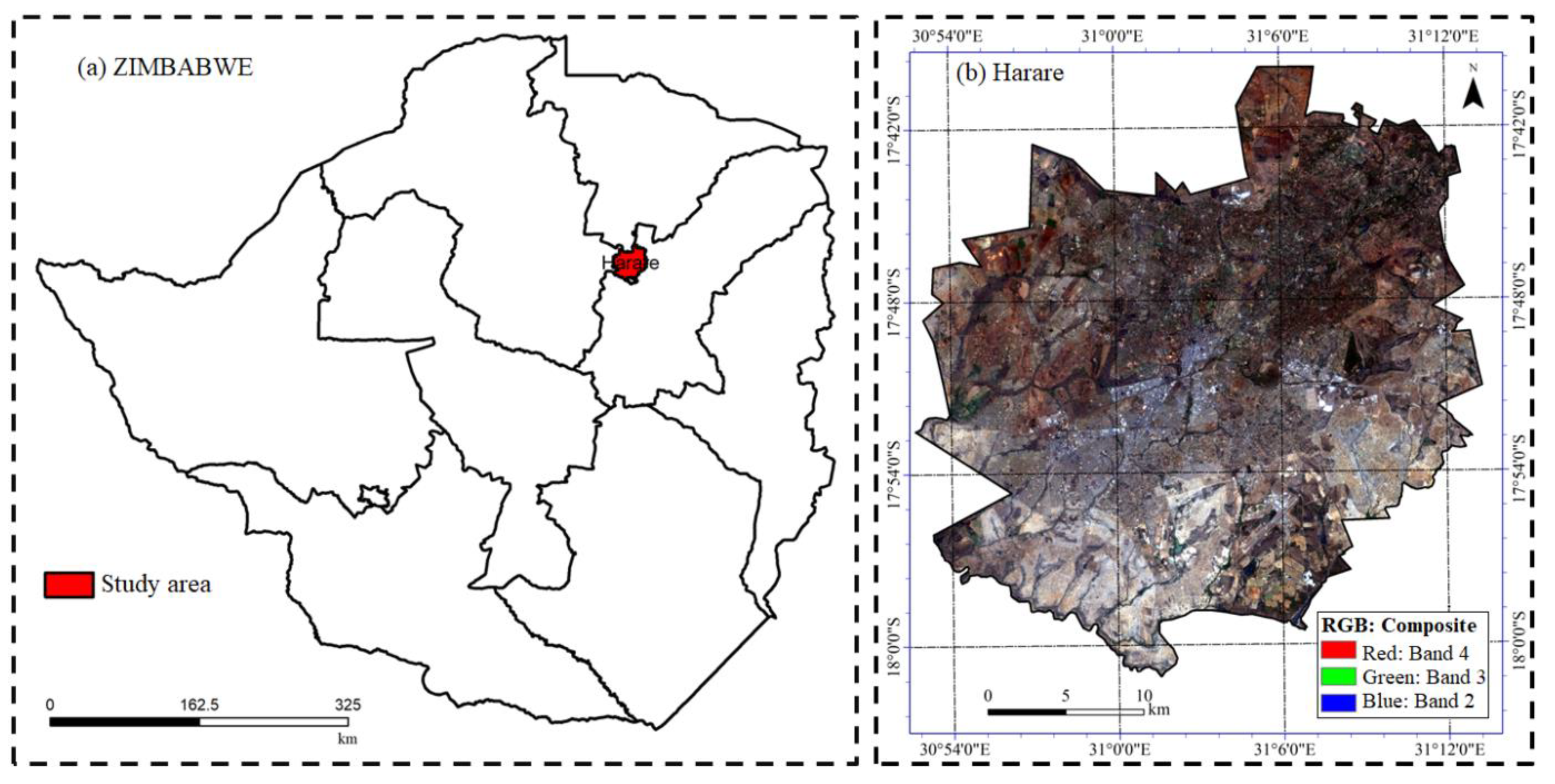

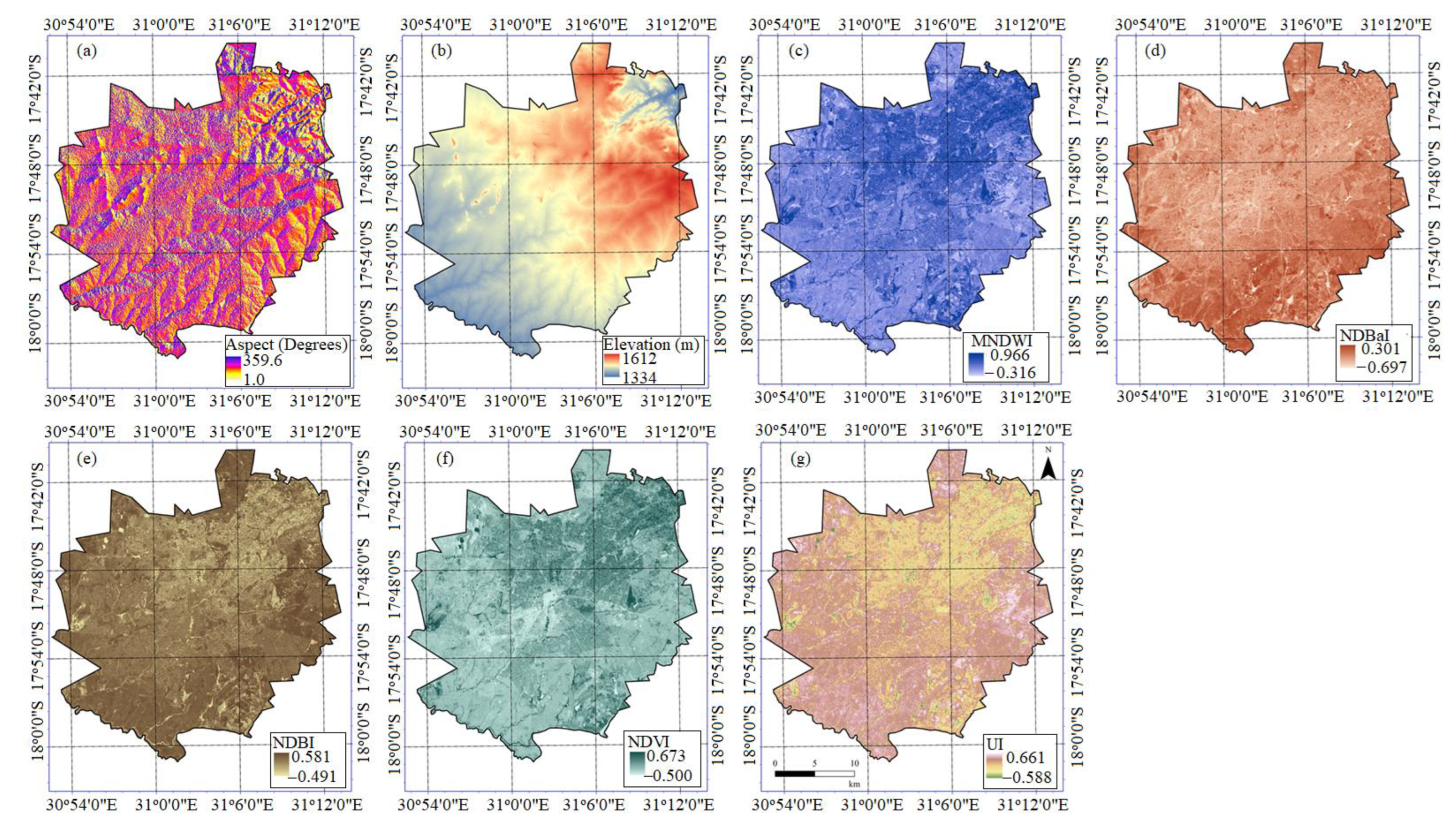

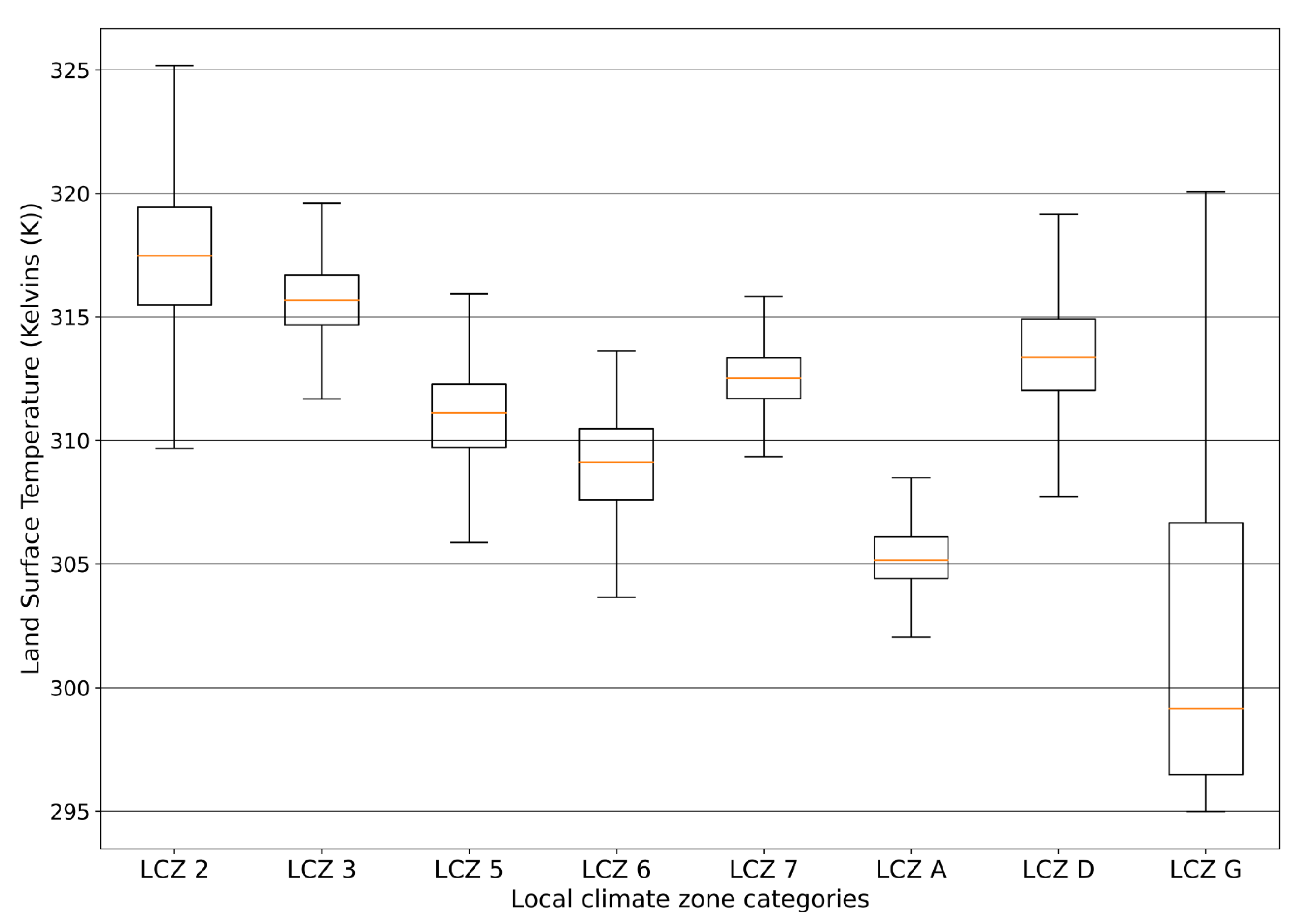

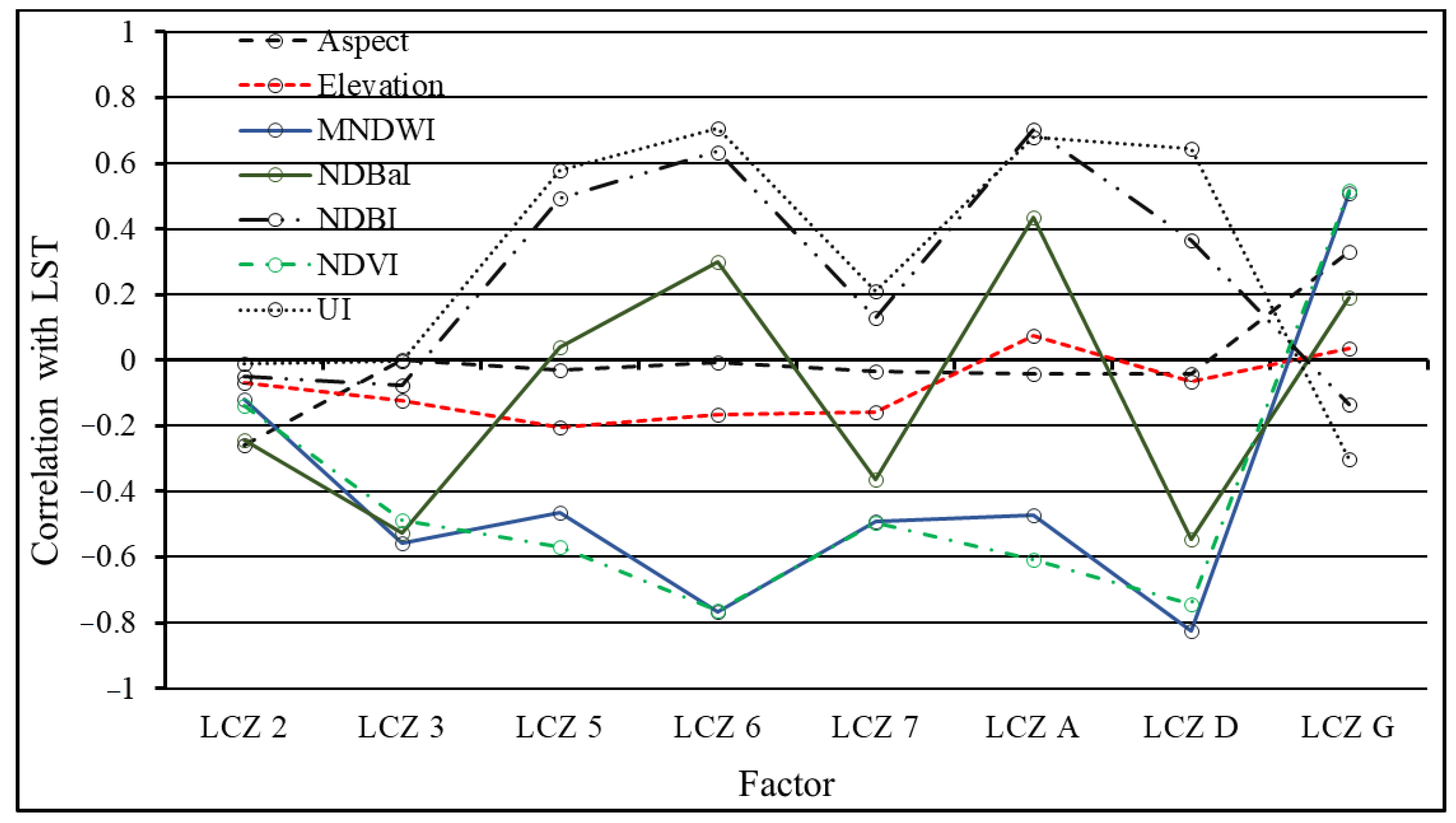
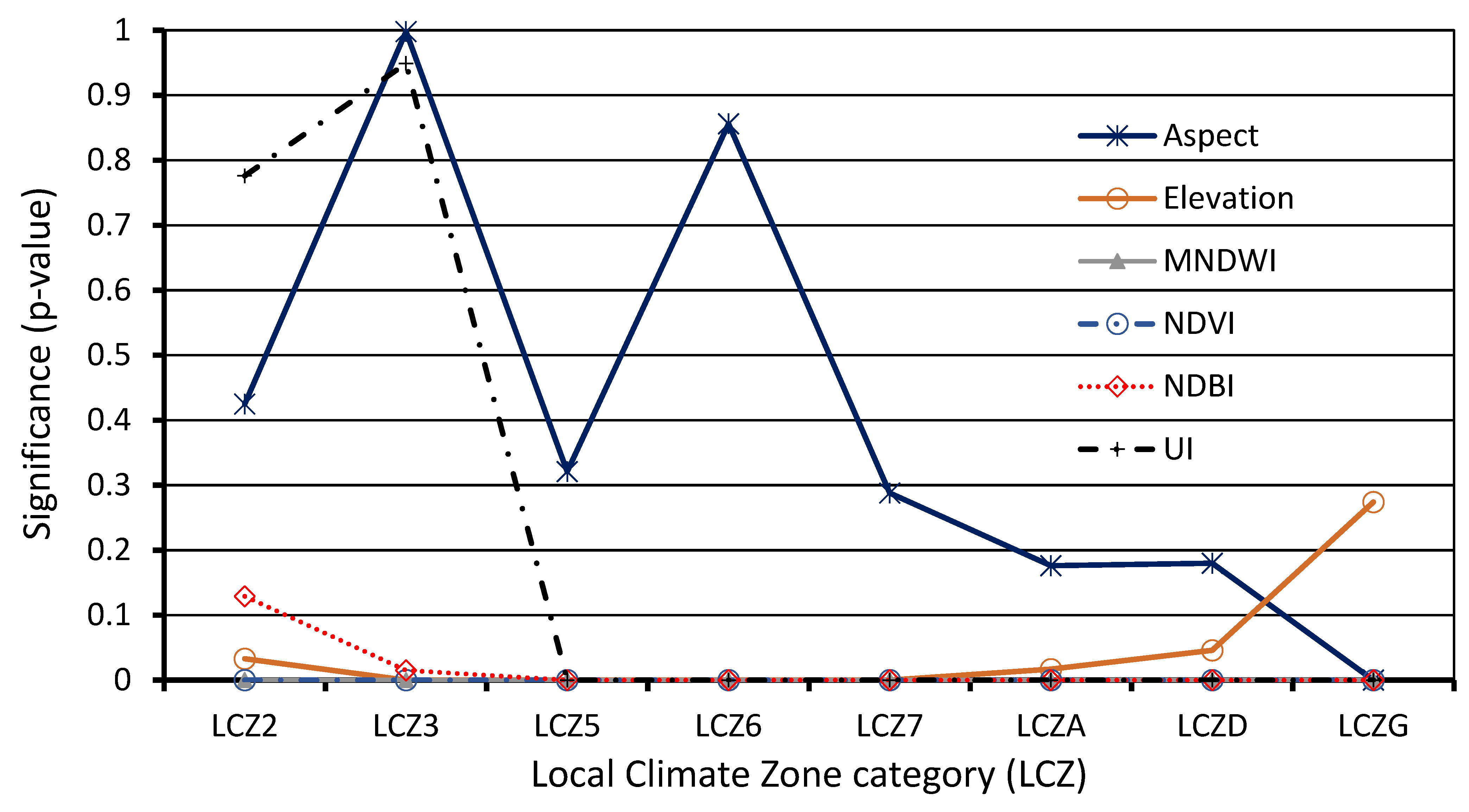
| LCZ Category | Producer Accuracy | User Accuracy |
|---|---|---|
| Compact lowrise | 89.45 | 76.45 |
| Compact midrise | 63.47 | 81.99 |
| Dense forest | 93.02 | 93.18 |
| Lightweight lowrise | 96.81 | 94.85 |
| Low plants | 90.98 | 98.43 |
| Open lowrise | 98.08 | 91.74 |
| Open midrise | 79.17 | 85.93 |
| Water | 100.00 | 100.00 |
| Paired LCZ Categories | Separability | |
|---|---|---|
| Category 1 | Category 2 | (TDSI Value) |
| Compact lowrise | Compact midrise | 1.071 |
| Open lowrise | Open midrise | 1.703 |
| Low plants | Open lowrise | 1.747 |
| Lightweight lowrise | Open lowrise | 1.779 |
| Compact lowrise | Lightweight lowrise | 1.804 |
| Lightweight lowrise | Open midrise | 1.871 |
| Compact midrise | Lightweight lowrise | 1.896 |
| Dense trees | Open lowrise | 1.953 |
| Low plants | Open midrise | 1.954 |
| Compact lowrise | Low plants | 1.963 |
| Lightweight lowrise | Low plants | 1.969 |
| Compact lowrise | Open lowrise | 1.982 |
| Compact lowrise | Open midrise | 1.984 |
| Dense trees | Low plants | 1.989 |
| Compact midrise | Low plants | 1.990 |
| Compact midrise | Open midrise | 1.990 |
| Compact midrise | Open lowrise | 1.997 |
| Dense trees | Open midrise | 2.000 |
| Compact lowrise | Dense trees | 2.000 |
| Dense trees | Lightweight lowrise | 2.000 |
| Lightweight lowrise | Water | 2.000 |
| Compact midrise | Dense trees | 2.000 |
| Compact midrise | Water | 2.000 |
| Low plants | Water | 2.000 |
| Open midrise | Water | 2.000 |
| Compact lowrise | Water | 2.000 |
| Open lowrise | Water | 2.000 |
| Dense trees | Water | 2.000 |
| Local Climate Zone (LCZ) | Average Temperature (K) | Anomaly Dt (K) | Coverage (ha) | Proportion-S (%) | Contribution Index |
|---|---|---|---|---|---|
| LCZ2 | 317.3 | 6.488 | 313.56 | 0.35 | 0.023 |
| LCZ3 | 315.9 | 5.087 | 3337.11 | 3.71 | 0.189 |
| LCZ5 | 311.1 | 0.288 | 1592.37 | 1.77 | 0.005 |
| LCZ6 | 309.0 | −1.813 | 32,483.61 | 36.08 | −0.654 |
| LCZ7 | 312.5 | 1.688 | 20,379.51 | 22.54 | 0.382 |
| LCZA | 305.2 | −5.613 | 2473.11 | 2.75 | −0.154 |
| LCZD | 313.5 | 2.688 | 29,130.39 | 32.36 | 0.870 |
| LCZG | 302.0 | −8.813 | 321.12 | 0.36 | −0.031 |
Publisher’s Note: MDPI stays neutral with regard to jurisdictional claims in published maps and institutional affiliations. |
© 2022 by the authors. Licensee MDPI, Basel, Switzerland. This article is an open access article distributed under the terms and conditions of the Creative Commons Attribution (CC BY) license (https://creativecommons.org/licenses/by/4.0/).
Share and Cite
Mushore, T.D.; Odindi, J.; Mutanga, O. Controls of Land Surface Temperature between and within Local Climate Zones: A Case Study of Harare in Zimbabwe. Appl. Sci. 2022, 12, 12774. https://doi.org/10.3390/app122412774
Mushore TD, Odindi J, Mutanga O. Controls of Land Surface Temperature between and within Local Climate Zones: A Case Study of Harare in Zimbabwe. Applied Sciences. 2022; 12(24):12774. https://doi.org/10.3390/app122412774
Chicago/Turabian StyleMushore, Terence Darlington, John Odindi, and Onisimo Mutanga. 2022. "Controls of Land Surface Temperature between and within Local Climate Zones: A Case Study of Harare in Zimbabwe" Applied Sciences 12, no. 24: 12774. https://doi.org/10.3390/app122412774
APA StyleMushore, T. D., Odindi, J., & Mutanga, O. (2022). Controls of Land Surface Temperature between and within Local Climate Zones: A Case Study of Harare in Zimbabwe. Applied Sciences, 12(24), 12774. https://doi.org/10.3390/app122412774








